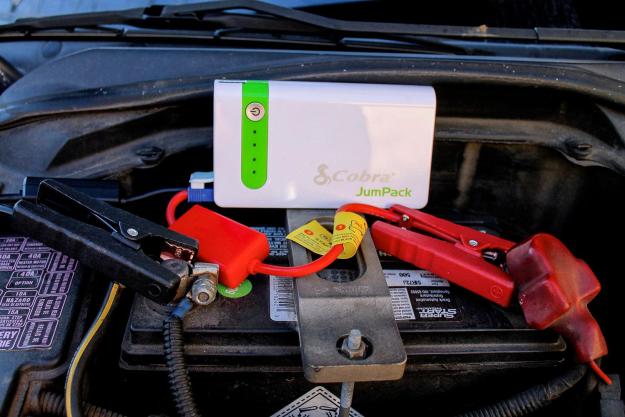
“Whether it’s a lifeless car or a dwindling cell, Cobra’s JumPack has the portable power to recharge your batteries”
- Small, lightweight and compact. Fits in a pocket!
- Easy to use
- Bright LED flashlight with multiple modes
- Ability to charge mobile devices
- May not have the power to jumpstart certain large vehicles
Some time ago, I worked as a lot attendant at a car dealership, and I was often asked to jump the dead vehicles left withering at the back of the premises. Doing so entailed lugging a ridiculously large, illogically heavy device across the property, which seemed like an antiquated way to do things. If you’ve ever done something similar, I feel your pain.
Thankfully, there’s a solution.
Cobra’s CPP 7500 JumPack is a portable jump starter about the size of an external hard drive. It weighs just less than 11 ounces and fits easily in most pockets — a stark contrast to the bulky wheeled units of the past.
Yes, the JumPack may be small, but it packs quite a punch.
It’s alive!
As I unwrapped the sleek white device for the first time, my father (who is more than familiar with cumbersome starter boxes) reacted with surprise.
Cobra’s CPP 7500 JumPack is a portable jump starter about the size of an external hard drive.
“There’s no way you’ll be able to jump a car with that little thing,” he remarked. “It won’t have enough power.”
But the JumPack not only has the power do it, it can do it multiple times with juice to spare.
After asking friends and scouring the streets for breakdowns, I finally found a car in need of a jump. With its 200-amp starting current and 400-amp peak current, the handheld unit jolted a completely dead vehicle back to life while still showing four out of four lights on the charge indicator.
The process is simple: turn off the car’s accessories, connect the included cables to the battery, plug them into the JumPack, turn it on, and turn the key. Better yet, after resurrecting your (or someone else’s) vehicle, you can even replenish the JumPack on your way home with the included 13.8-volt DC car charger.
It is worth noting that the JumPack’s power output may not be sufficient to jump certain large engines multiple times. Check your vehicle’s specs before buying, because if it requires more than 200A (400A peak) to start, this may not be the device for you.
For the overwhelming majority, though, the JumPack will work just fine. A quick scan of the interwebs will net you countless stories of people jumping V8-powered Suburbans, trucks, jet-skis, and other vehicles in a variety of weather conditions with no issues.
Jumping your car is just the start
With all this portable power on hand, it would be a waste to use it all in one place. Luckily, there are several other ways that Cobra’s JumPack comes in handy.
The first and most obvious is its ability to charge mobile devices through its 5V, 2.1A USB port. With the proper USB cable (not included), you can charge most tablets, smartphones, and music players easily. When plugged into a dead iPad, the JumPack charged it to about 15 percent in an hour, running the Apple battery up to 50 percent before calling it quits.
So while it may not be the cure-all for charging electronics over long camping trips, the portable jump starter comes in handy in a variety of ways. It can also be fully charged via the included wall charger in a few hours.
Another feature is the high-intensity LED light on the front, which is bright enough to illuminate your engine bay or even signal for roadside help. The light has three modes: steady, strobe, and S.O.S. The only thing missing is an onboard taser.
Conclusion
The DT Accessory Pack
Up your game and the get the most out of your gear with the following extras, hand-picked by our editors:
4-in-1 USB charger ($9)
With its USB plug, this adapter will allow you to charge almost all smartphones, music players, tablets, and more straight from Cobra’s JumPack.
Accutire MS-4021B Digital Tire Pressure Gauge ($12)
Tires a bit low? Try this digital pressure gauge from Accutire, accurate to within 0.05 PSI.
AAA 66-piece Severe Weather Road Kit ($43)
To help keep you safe during a breakdown, this roadside assistance kit features warm fleece gloves, emergency candles, a folding shovel, an ice scraper, a whistle, and first aid supplies.
But there are a few big differences: Those take up a lot of room in the trunk, they don’t always come with lights, and they won’t help you finish that game of Trivia Crack before your cell battery dies.
Outside of that, there isn’t much to say about the Cobra CPP 7500 JumPack. It’s a simple product that does what it does well, while also providing some cool features to bring jump starters into the modern age. Now, if only it would fill the gas tank.
Highs
- Small, lightweight and compact. Fits in a pocket!
Easy to use
Bright LED flashlight with multiple modes
Ability to charge mobile devices
Lows
- May not have the power to jumpstart certain large vehicles






